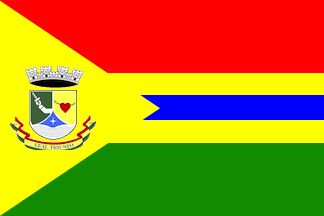 image by Ivan Sache, 7 August 2020
image by Ivan Sache, 7 August 2020
Last modified: 2020-08-08 by ian macdonald
Keywords: rio grande do sul | triunfo |
Links: FOTW homepage |
search |
disclaimer and copyright |
write us |
mirrors
 image by Ivan Sache, 7 August 2020
image by Ivan Sache, 7 August 2020
The municipality of Triunfo (2",311 inhabitants in 2015; 82,342 ha) is
located 80 km north of Porto Alegre.
Triunfo originates in the grant in
1752 y General Gomes Freire de Andrade, Governor general of the Captaincy of Rio
Grande do Sul, of two domains to Manoel Gonçalves Meirelles and Francisco da
Silva, two sons-in-law of Jerônimo de Ornelas Menezes e Vasconcellos, the
founder of Porto Alegre, and Lucrecia Leme Barbosa. Ornelas moved in 1757 to Bom
Jesus de Triunfo, where he died in 1771. Meirelles died in Triunfo in 1777. His
sixth daughter, Perpétua da Costa Meirelles, married Captain Joaquim Gonçalves
da Silva, a Portuguese from Santa Marinha Real, and was the mother of Bento
Gonçalves da Silva.
On 4 September 1756, Antônio do Desterro, Bishop of
Rio de Janeiro, commissioned Father Tomás Clarque to organize the third parish
in Rio Grande do Sul, Bom Jesus de Triunfo, in a place originally known as
Forquilha (Small Fork) for the confluence of rivers Taquari and Jacuí.
The
municipality of Triunfo was established by a Decree promulgated on 25 October
1831.
https://www.triunfo.rs.gov.br/
Municipal website
Ivan Sache, 7 August 2020
Horizontally striped, red-yellow-blue-yellow-green, 3-1-1-1-3, with the municipal arms on a yellow triangle extending from the hoist.
Official website at
http://www.triunfo.rs.gov.br
Dirk Schönberger, 27 April 2012
The flag of Triunfo is prescribed by Municipal Law No. 262 promulgated on 23
November 1972.
Article 5
§1. The coat of arms applied on the flag
represents the municipal government, while the yellow isosceles triangle
containing it represents the town proper, as the seat of the municipality. The
triangle is the heraldic symbol of liberty, equality and fraternity. Yellow is a
symbol of glory, greatness, wealth, splendor and sovereignty. The central yellow
stripe charged with a blue stripe, starting from the triangle's point,
represents the spread of the municipal power over the whole territory. Blue is a
symbol of justice, nobleness, perseverance, zeal and loyalty. The red and green
lateral stripes represent the rural estates scattered over the municipal
territory. Red is a symbol of dedication, patriotic love, audacity, intrepidity,
courage, valiance. Green is a symbol of honor, civility, courtesy, glee and
hope, since greening fields in spring promise profuse harvests.
Article
7.
In compliance with heraldic rules the municipal flag shall have the
official dimensions prescribed for the national flag, that is, 14 units in width
on 20 units in length.
https://leismunicipais.com.br/a/rs/t/triunfo/lei-ordinaria/1972/27/262/lei-ordinaria-n-262-1972-dispoe-sobre-a-forma-e-a-apresentacao-da-bandeira-do-municipio-de-triunfo
Leis Municipais database
The coat of arms of Triunfo is prescribed by
Municipal Law No. 48 promulgated on 7 May 1960.
Article 1.
Portuguese
shield divided per pale and grafted in base. In chief on a field vert (green) a
right arm amred with an old sword pointing dexterwise all argent the sword's
hilt sable (iron black), recalling the foundationby the bandeirantes Jerônimo de
Ornelas Menezes e Vasconcelos and his wife, Lucrécia Leme, and also the heroes
of the fightings in Fanfa island and in the town during the Ragamuffin
Revolution, the stainless figures of Bento Gonçalves da Silva, Luiz Ribeiro
Barreto and other who contributed to the political, scoial and administrative
life of the state. In counter-chief, on a field or a heart gules (red) supported
by iron links (sable), recalling the old name of the place, Bom Jesus de Triunfo,
and a tribute to the municipality's patron saint. In base on a field azure
(blue) waves argent recalling rivers Jacuí and Taquari, which waters the
municipality, surmounted by a black four-pointed star, recalling the role of the
municiplaity in history and traditions, and as a symbol of its activities in
various sectors of industry.
A four-towered mural crown argent.
A scroll
gules, or and vert, the fess or inscribe "LEAL TRIUNFO" [Loyal Triunfo].
https://leismunicipais.com.br/a/rs/t/triunfo/lei-ordinaria/1960/5/48/lei-ordinaria-n-48-1960-cria-e-adota-o-brasao-de-armas-para-simbolo-do-municipio-de-triunfo
Leis Municipais database
Jerônimo de Ornelas Menezes e Vasconcelos
(1691-1771), born in Madeira, is no longer considered by modern historians as
the founder of Portov Alegre since he did not developed any permanent settlement
in his domain.
General Bento Gonçalves da Silva (1788-1847) was one of
the leaders of the Ragamuffin Revolution. Captured on 4 October 1836 during the
Fanfa battle, Bento Gonçalves was jailed in Bahia, which did not prevent him to
be proclaimed the first President of the secessionist Riograndense Republic
(1836-1841). He escaped and headed to Rio Grande do Sul via Buenos Aires, where
he was actually proclaimed President on 16 December 1837. The secessionist state
ended with the Treaty of Poncho Verde, signed on 1 March 1845, and Bento
Gonçalves returned to civil life.
Luís José Ribeiro Barreto (1801-?1888)
was Minister of War of the Ragamuffin Republic and founded in Triunfo Theatro
União (1848), Brazil's second oldest theater.
Photos
https://www.facebook.com/PrefTriunfoRS/photos/a.1145573622235431/2590878234371622/?type=3&theater
https://www.facebook.com/PrefTriunfoRS/photos/a.1145280625598064/2481594648633315/?type=3&theater
Ivan Sache, 7 August 2020